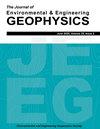Bayesian Time-lapse Difference Inversion Based on the exact Zoeppritz Equations with Blockiness Constraint
IF 0.7
4区 工程技术
Q4 ENGINEERING, GEOLOGICAL
引用次数: 7
Abstract
Accurately inverting changes in the reservoir elastic parameters that are caused by oil and gas exploitation is of great importance in accurately describing reservoir dynamics and enhancing recovery. Previously numerous time-lapse seismic inversion methods based on the approximate formulas of exact Zoeppritz equations or wave equations have been used to estimate these changes. However the low accuracy of calculations using approximate formulas and the significant calculation effort for the wave equations seriously limits the field application of these methods. However, these limitations can be overcome by using exact Zoeppritz equations. Therefore, we study the time-lapse seismic difference inversion method using the exact Zoeppritz equations. Firstly, the forward equation of time-lapse seismic difference data is derived based on the exact Zoeppritz equations. Secondly, the objective function based on Bayesian inversion theory is constructed using this equation, with the changes in elastic parameters assumed to obey a Gaussian distribution. In order to capture the sharp time-lapse changes of elastic parameters and further enhance the resolution of the inversion results, the blockiness constraint, which follows the differentiable Laplace distribution, is added to the prior Gaussian background model. All examples of its application show that the proposed method can obtain stable and reasonable P- and S-wave velocities and density changes from the difference data. The accuracy of estimation is higher than for existing methods, which verifies the effectiveness and feasibility of the new method. It can provide high-quality seismic inversion results for dynamic detailed reservoir description and well location during development.基于块约束的精确Zoeppritz方程的贝叶斯时延差分反演
准确反演油气开采引起的储层弹性参数变化,对准确描述储层动态、提高采收率具有重要意义。以前有许多基于精确Zoeppritz方程或波动方程近似公式的时移地震反演方法被用来估计这些变化。但是,近似公式计算精度低,波动方程计算量大,严重限制了这些方法的实际应用。然而,这些限制可以通过使用精确的Zoeppritz方程来克服。因此,我们研究了采用精确Zoeppritz方程的时移地震差分反演方法。首先,基于精确的Zoeppritz方程,推导了时移地震差分资料的正演方程;其次,利用该方程构造基于贝叶斯反演理论的目标函数,并假设弹性参数的变化服从高斯分布;为了捕捉弹性参数随时间变化的剧烈变化,进一步提高反演结果的分辨率,在先验高斯背景模型中加入遵循可微拉普拉斯分布的块性约束。应用实例表明,该方法能从差值数据中得到稳定合理的纵波速度和密度变化。估计精度高于现有方法,验证了新方法的有效性和可行性。该方法可为开发过程中动态详细的储层描述和井位定位提供高质量的地震反演结果。
本文章由计算机程序翻译,如有差异,请以英文原文为准。
求助全文
约1分钟内获得全文
求助全文
来源期刊

Journal of Environmental and Engineering Geophysics
地学-地球化学与地球物理
CiteScore
2.70
自引率
0.00%
发文量
13
审稿时长
6 months
期刊介绍:
The JEEG (ISSN 1083-1363) is the peer-reviewed journal of the Environmental and Engineering Geophysical Society (EEGS). JEEG welcomes manuscripts on new developments in near-surface geophysics applied to environmental, engineering, and mining issues, as well as novel near-surface geophysics case histories and descriptions of new hardware aimed at the near-surface geophysics community.
 求助内容:
求助内容: 应助结果提醒方式:
应助结果提醒方式:


